-202403121604.gif)


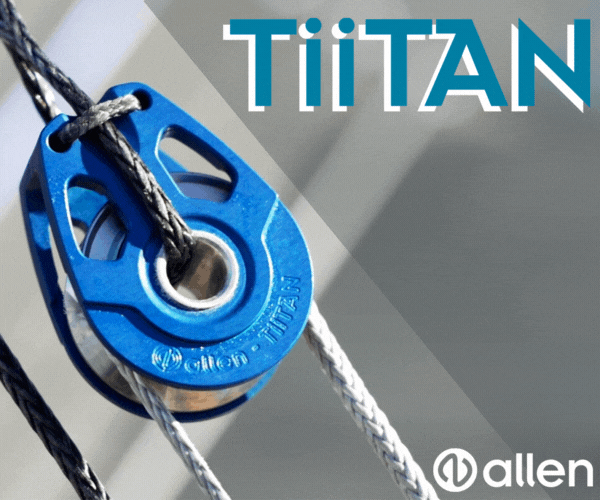


-YandY-202303241230.gif)
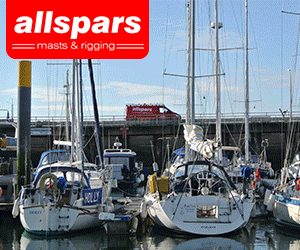
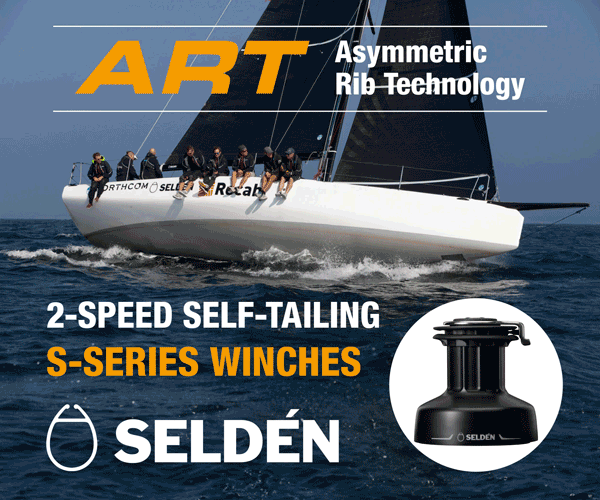



Boats for sale
| Laser XD 203301 Upminster |
 |
| Laurent Giles 'Jolly Boat' Exeter |
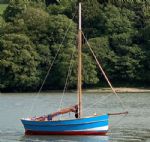 |
| J24 (Sail No. 4239) Dartmouth |
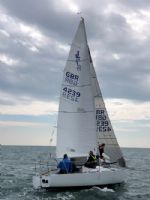 |
List classes of boat for sale |
Sailing in tide..quiz. |
Post Reply 
|
Page <1 7891011> |
| Author | |||
Guests 
Guest Group 
|
 Post Options Post Options
 Quote Quote  Reply Reply
 Topic: Sailing in tide..quiz. Topic: Sailing in tide..quiz.Posted: 09 Oct 17 at 12:21pm |
||
|
Watch from 10 minutes in... Edited by mozzy - 09 Oct 17 at 12:22pm |
|||
 |
|||
Guests 
Guest Group 
|
 Post Options Post Options
 Quote Quote  Reply Reply
 Posted: 10 Oct 17 at 8:00am Posted: 10 Oct 17 at 8:00am |
||
Boats sit still on a becalmed lake because there are no aerodynamic or hydrodynamic forces to move them. However, if the water is moving due to a current, there are hydrodynamic forces in play. Each boat will then accelerate until they achieve a steady velocity (in the direction of the current) and with a magnitude such that the drag of the boat moving through the water is equal to the force of the water (current) on the boat. This requires that the boat speed must be less than current speed, because if the boat moved at the speed of the current there would be no hydrodynamic force. The boat would have to slow down until such time as the hydrodynamic force equalled the drag again. This is true even ignoring aero drag. So I maintain that boats drift downtide at a speed less than the current. This doesn't alter the basis of the argument that a shift in apparent wind occurs, but the size of that shift might not be as big as expected.
|
|||
 |
|||
Guests 
Guest Group 
|
 Post Options Post Options
 Quote Quote  Reply Reply
 Posted: 10 Oct 17 at 9:08am Posted: 10 Oct 17 at 9:08am |
||
What are these 'hydrodynamic forces' you talk of? if the boat is stationary in the water (albeit moving in relation to the land)?
If the boat achieves a steady velocity in the direction of the current there is no force from the water. Newton's first law. Once the boat is accelerated up to the speed of the current and reaches a steady speed it will remain in that uniform motion. I.e. it needs no additional water force to keep moving. Put it another way: The water on your lake is moving at 1000 miles an hour and yet when you put a boat in it, and it is becalmed, it doesn't move through the water. Or, imagine a boat on an achor: In 2 knots of tide a boat at anchor (fixed to the land) will experience 2 knots of flow past it's hull. On the boat it will appear as if your anchor line is pulling you through the water at 2 knots. Relative to the land you will be stationary. Release the boat from it's mooring and it accelerates up to 2 knots until the water is now longer flowing past the boat, on the boat you will be stationary in the water. From the land the boat will now be moving at 2 knots with the current. Edited by mozzy - 10 Oct 17 at 9:09am |
|||
 |
|||
Sam.Spoons 
Really should get out more 
Joined: 07 Mar 12 Location: Manchester UK Online Status: Offline Posts: 3398 |
 Post Options Post Options
 Quote Quote  Reply Reply
 Posted: 10 Oct 17 at 9:21am Posted: 10 Oct 17 at 9:21am |
||
|
I agree with mozzy. The only thing causing the boat to move at less than the speed of the current is aerodynamic drag, in the hypothetical situation of the wind exactly matching the current in speed and direction the boat would quite soon exactly match the current (and wind) speed and would appear becalmed. If there was truly no wind (which is actually much more likely than the wind exactly matching the current) the boat would not appear becalmed but would experience an apparent wind with a vector exactly opposite to the current.
The interesting question is "would that apparent wind be sufficient to allow a boat to make progress against the tide?" (I think no but I could be wrong)
 |
|||
|
Spice 346 "Flat Broke"
Blaze 671 "supersonic soap dish" |
|||
 |
|||
iGRF 
Really should get out more 

Joined: 07 Mar 11 Location: Hythe Online Status: Offline Posts: 6496 |
 Post Options Post Options
 Quote Quote  Reply Reply
 Posted: 10 Oct 17 at 9:22am Posted: 10 Oct 17 at 9:22am |
||
|
I can't see that link, but it's pointless to argue with him, he's done his maths, he can't possibly be wrong.

|
|||
 |
|||
iGRF 
Really should get out more 

Joined: 07 Mar 11 Location: Hythe Online Status: Offline Posts: 6496 |
 Post Options Post Options
 Quote Quote  Reply Reply
 Posted: 10 Oct 17 at 10:12am Posted: 10 Oct 17 at 10:12am |
||
|
I think it's time for another anecdote.
Once upon a time they used to hold a race up the Thames, there were hundreds of boards. The race went ahead wind or no, because we sailed with the tide. So with no wind whatsoever we criss crossed the river the water movement creating a 'true' wind and the movement we generated forward producing a 'created'wind so our apparent wind was exactly where it might be if the true wind were the couple of knots that the current generated. But what was wierd, as you might normally do, watch up wind for wind obstacles, trees, bushes etc, it didn't matter, even under bridges, no change the only thing that was important was to judge where the tidal flow was greater and play the shorter routes the bends in the river allowed, from Putney up to Barnes as I recall. But,here's a thing even as the river bent around the bend, no change in the appearance of a wind direction, both tack were equal, very little difference the only place changes that occurred were thanks to tidal flow points and being boards with a free sail rig, you could feel them. Now finally that other point about boards, the reason the tide is very important is that the planing threshold for a board is around 8 knots wind, give or take board volumes widths etc, so if you have only 5 knots of wind, but find 3 knots of tide, you get to plane which then increases the created wind and you plane even better, you can even pump yourself onto the plane and stay there, it's not something you can easily describe to fixed rig sailors, but like ice yachting, it works. |
|||
 |
|||
Guests 
Guest Group 
|
 Post Options Post Options
 Quote Quote  Reply Reply
 Posted: 10 Oct 17 at 10:55am Posted: 10 Oct 17 at 10:55am |
||
Pretty similar planing speed to the 49er I used to sail. Not only would getting in tide take you to the mark 3 knots quicker, but you would be sailing in 8 knots breeze. 8 knots was enough for you to plane so you would see a significant increase in boat speed through the water. 29er was the same, but you needed more like 10-12 knots. Interestingly, for moths, if it is wind against tide, they are better sailing against more tide downwind. The increase in boat speed from the additional apparent more than outweighs the additional distance they have to sail through the water. Only works for boats which have VMG greater the wind though.
Edited by mozzy - 10 Oct 17 at 10:56am |
|||
 |
|||
Guests 
Guest Group 
|
 Post Options Post Options
 Quote Quote  Reply Reply
 Posted: 10 Oct 17 at 9:12pm Posted: 10 Oct 17 at 9:12pm |
||
Your anchor scenario is exactly my point. Here you have hydrodynamic forces acting on the hull and tension in the anchor cable is holding it still. Cut the cable, the hydrodynamic force now accelerates the boat until the drag of the hull equals the hydrodynamic force. At this point the boat moves at constant velocity, but the magnitude of that velocity surely depends on how draggy the hull is.
|
|||
 |
|||
sargesail 
Really should get out more 
Joined: 14 Jan 06 Location: United Kingdom Online Status: Offline Posts: 1459 |
 Post Options Post Options
 Quote Quote  Reply Reply
 Posted: 10 Oct 17 at 9:35pm Posted: 10 Oct 17 at 9:35pm |
||
|
No it doesn't. The hydrodynamic drag will affect the acceleration....the change in velocity. Given 2 boats of different profile both end up accelerating......and as they approach the speed of the current the flow past the hull tends to zero....so that the hydrodynamic drag tends to zero so that the difference in hydrodynamic drag tends to be even smaller than that..... A 'fascinating' race during that very high pressure week in June.....drifting up and down the Solent with the same piece of flotsam alongside us.
|
|||
 |
|||
Guests 
Guest Group 
|
 Post Options Post Options
 Quote Quote  Reply Reply
 Posted: 10 Oct 17 at 9:35pm Posted: 10 Oct 17 at 9:35pm |
||
|
How quickly the boat reaches equilibrium will depend on it's weight and how 'draggy' it is.
The point is, shortly after coming off the anchor, that force (the anchor) is no longer acting on he boat and it slows through the water to zero. Once it's off the anchor the only forces pushing the boat through the water is the sheer between wind and water. The tide doesn't move a boat through the water, because the tide is the water. So how fast a boat moves through the water does not depend on tide, but on how much power the sails have and how draggy the hull is, exactly the same as a lake.
Edited by mozzy - 10 Oct 17 at 9:37pm |
|||
 |
|||
Post Reply 
|
Page <1 7891011> |
| Forum Jump | Forum Permissions  You cannot post new topics in this forum You cannot reply to topics in this forum You cannot delete your posts in this forum You cannot edit your posts in this forum You cannot create polls in this forum You cannot vote in polls in this forum |
Bulletin Board Software by Web Wiz Forums® version 9.665y
Copyright ©2001-2010 Web Wiz
Change your personal settings, or read our privacy policy
Copyright ©2001-2010 Web Wiz
Change your personal settings, or read our privacy policy











 Printable Version
Printable Version Delicious
Delicious Digg
Digg Facebook
Facebook Furl
Furl Google
Google MySpace
MySpace Newsvine
Newsvine reddit
reddit StumbleUpon
StumbleUpon Twitter
Twitter Windows Live
Windows Live Yahoo Bookmarks
Yahoo Bookmarks Topic Options
Topic Options